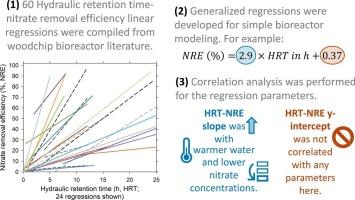Quantitative synthesis of the denitrifying bioreactor hydraulic retention time-nitrate removal efficiency relationship
IF 4.1
2区 环境科学与生态学
Q1 ECOLOGY
引用次数: 0
Abstract
Denitrifying woodchip bioreactors consistently exhibit a strong positive relationship between hydraulic retention time (HRT) and nitrate (N) removal efficiency (NRE), expressed as a percent. This robust HRT-NRE linear regression provides an empirical tool for simply estimating bioreactor performance, but regression parameters (slope, y-intercept) vary across studies. The objective of this quantitative synthesis was to assess the impact of study conditions (e.g., water temperature, N concentration, woodchip porosity, study scale) on the HRT-NRE linear regression slope and y-intercept. A total of 60 HRT-NRE linear regression slopes and y-intercepts were extracted from 26 woodchip bioreactor studies. The individual regression slopes ranged from 0.13 to 18 %/h (median: 2.9 %/h) and y-intercepts ranged from −19 to +47 % (median: 0.37 %). The HRT-NRE slopes were positively correlated with water temperature (Spearman correlation coefficient ρ: +0.39) and negatively correlated with inflow N concentration (ρ: −0.46). The regression y-intercepts were not correlated with any parameter compiled here; they may be a function of other water or wood chemistry parameters. Generalized HRT-NRE models were developed for the entire database (n = 60) and for a subset of data most representative of subsurface drainage (“Tile Proxy”, n = 24). The simple linear regression linking denitrifying bioreactor HRT and NRE is a straightforward empirical tool that will benefit from further: (1) assessment of varying the HRT using the flow rate versus sampling along the reactor length and (2) increased transparency in methods for estimating woodchip porosity.

定量合成反硝化生物反应器水力停留时间-硝酸盐去除效率关系
反硝化木屑生物反应器始终表现出水力停留时间(HRT)与硝酸盐(N)去除效率(NRE)之间强烈的正相关关系,以百分比表示。这种稳健的HRT-NRE线性回归提供了简单估计生物反应器性能的经验工具,但回归参数(斜率,y截距)在不同的研究中有所不同。本次定量综合的目的是评估研究条件(如水温、N浓度、木屑孔隙度、研究规模)对HRT-NRE线性回归斜率和y截距的影响。从26个木屑生物反应器研究中提取了60个HRT-NRE线性回归斜率和y截距。个体回归斜率范围为0.13至18% /h(中位数:2.9% /h), y截距范围为- 19至+ 47%(中位数:0.37%)。HRT-NRE坡度与水温呈正相关(Spearman相关系数ρ: +0.39),与入流氮浓度负相关(ρ:−0.46)。回归y截距与这里编译的任何参数都不相关;它们可能是其他水或木材化学参数的函数。为整个数据库(n = 60)和最具地下排水代表性的数据子集(“Tile Proxy”,n = 24)开发了广义HRT-NRE模型。将反硝化生物反应器HRT和NRE联系起来的简单线性回归是一种直观的经验工具,它将受益于以下方面:(1)利用流速与沿着反应器长度采样来评估HRT的变化;(2)提高木屑孔隙度估算方法的透明度。
本文章由计算机程序翻译,如有差异,请以英文原文为准。
求助全文
约1分钟内获得全文
求助全文
来源期刊

Ecological Engineering
环境科学-工程:环境
CiteScore
8.00
自引率
5.30%
发文量
293
审稿时长
57 days
期刊介绍:
Ecological engineering has been defined as the design of ecosystems for the mutual benefit of humans and nature. The journal is meant for ecologists who, because of their research interests or occupation, are involved in designing, monitoring, or restoring ecosystems, and can serve as a bridge between ecologists and engineers.
Specific topics covered in the journal include: habitat reconstruction; ecotechnology; synthetic ecology; bioengineering; restoration ecology; ecology conservation; ecosystem rehabilitation; stream and river restoration; reclamation ecology; non-renewable resource conservation. Descriptions of specific applications of ecological engineering are acceptable only when situated within context of adding novelty to current research and emphasizing ecosystem restoration. We do not accept purely descriptive reports on ecosystem structures (such as vegetation surveys), purely physical assessment of materials that can be used for ecological restoration, small-model studies carried out in the laboratory or greenhouse with artificial (waste)water or crop studies, or case studies on conventional wastewater treatment and eutrophication that do not offer an ecosystem restoration approach within the paper.
 求助内容:
求助内容: 应助结果提醒方式:
应助结果提醒方式:


